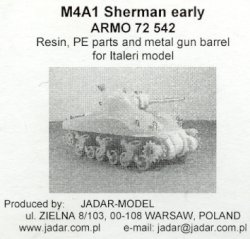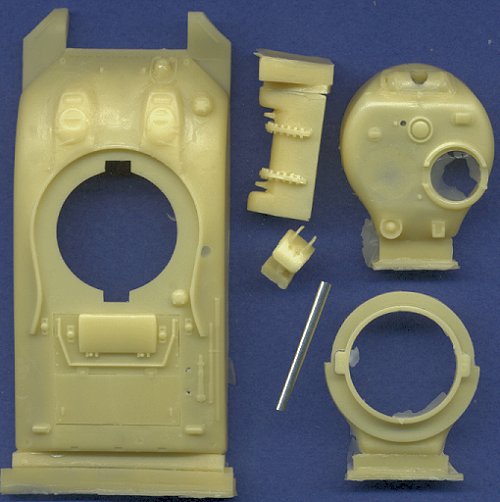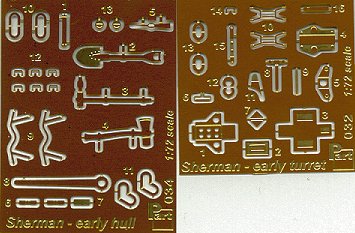ARMO Article by Doug Chaltry; last updated 31 October 2007.
Well, it doesn't happen often, but every now and again I have to review a poor item, and unfortunately this is one of them. It is really too bad, because of my great interest in Sherman tanks, plus the fact that ARMO has always been one of my favorite resin manufacturers. But this kit simply is not up to the normal standards of that company. A couple of years ago, ARMO released a series of conversion kits to be used with the Italeri (formerly ESCI) M4A1 Sherman kit. The conversions were intended to fill a gap in the availability of Sherman models with the early-style hull, which at that time, had been provided only as a plastic wargaming kit from HaT, plus a superb example of an early M4A2 in resin from MR Models. ARMO released two versions each of the M4, M4A1 and M4A2, as well as a couple unique versions such as some early Fireflies. For each of the pairs of kits, they are labeled one each as "early" and "late", which is deceptive in a way, since these are all "early" Shermans. The "early" and "late" designations refer to two distinctions between each kit: the nose piece (final drive housing) and the gun shield. The "early" versions of each of the M4, M4A1 and M4A2 have the early, three-piece bolted nose and the M34 gun mantlet (without the armored wings), and the "late" versions have the mid-series, rounded, cast nose, as well as the later M34A1 gun mantlet (with the armored wings, as seen in the Italeri kit). But again, in all cases, the hull is the early, 56°, small hatch version. One curiosity is that the "early" versions of these tanks don't have the direct vision slots on the hull front. The direct vision slots are view ports in the hull armor directly in front of the driver and radio operator, which allowed them to look directly forward without the need of any offset vision devices. But since these view ports compromised the armor of the hull front, they were replaced with periscopes that protruded from the top of the hull in front of the hatches. So it would have been more appropriate to add these direct vision slots to the "early" versions of these kits, but I imagine it will be quite easy to do that ourselves.
It should first be noted that these ARMO conversions were made by altering the Italeri (ESCI) plastic Sherman, which means that there are a couple of weaknesses inherited from that model. Specifically, the hull is slightly short (about 2mm), and some of the surface detail is fairly basic, such as the fluid filler caps and ventilators. I consider them to be acceptable, but certainly not great. The main problem that I have with this particular kit (the "early" M4A1) is that it appears as though the conversion work was only half completed. The front hull was removed and replaced with putty, which was then carved into shape. While ARMO appears to have gotten the shape pretty accurate, they did a very rough job of it. The two bulges in the front armor plate, in front of the two crew hatches, are not evenly shaped. Also, the surface of the new front armor is very rough, as though a file was used to get the general shape, but then they forgot to finish up with some sandpaper to smooth everything to a flat surface. It's possible that the modeler can finish the job himself with some sandpaper, but it would have been much easier to sand the putty of the master parts, than the resin of the cast parts. The two crew hatches are molded closed, and they are very indistinct, and can barely be differentiated from the hull. Why did they mold them closed? When I first opened the package, I was happy to see that the kit was actually molded with a hollow cast hull and turret, just like the plastic parts of the ESCI kit. But what is the advantage of having a hollow cast hull, if the hatches are molded shut? The rear of the hull is also in need of some cleanup work. Some of the molded on detail was removed from the plastic part, and the locator holes for other tools and hull details were "filled" with putty. Again, nothing was sanded smooth, and the modeler will have to repeat the putty and sanding work. And why were the engine access hatches molded closed? The Italeri Sherman kit comes with a complete engine and open engine bay, which is highly unusual for models in this scale. This neat design feature has now been nullified in this conversion set, because of the closed engine hatches. Now we get to the turret. As with the hull, this is a modified plastic piece from the original ESCI kit. It is modified by "filling" in the loader's hatch, and altering the gun mount to represent the early M34 mount. The gun mount alterations aren't too bad, but once again, the hatch filling and sanding need to be redone by the modeler. On the positive side of things, at least the commander's hatch was left open.
As for the other kit parts, a very nice turned aluminum gun barrel is included (but it doesn't fit into the mantlet), and the photoetched parts are done by PART, and with the exception of all the brass wasted on the pioneer tools, there are many useful pieces here. I certainly hope that ARMO will market the gun barrel separately, since as of this writing, the only 75mm Sherman barrel they offer is designed for the Airfix Sherman kit, and is very underscale. So what about the other kits in this series? Well, based on this kit I have in hand, I would be very reluctant to buy the other ARMO M4A1. I've looked closely at the photos of the built models on the JADAR website, but the resolution and lighting of the photos are too poor to be able to judge whether or not I just got a bum sample, or if they are all like this. As for the welded hull versions, the M4 and M4A2, it appears as though those may be done a little more cleanly than this one, since it is easier to sand flat plates, but they may share the same weaknesses of the turret and rear hull. To me, the bottom line for this kit is that it is not a great model, but is it better than nothing? Probably. Since I lack the motivation to attempt such a conversion from scratch, it would be easier for me to improve upon this flawed item provided by ARMO. Plus, Dragon has recently released a version of the early M4A1, and with some kit bashing, can be altered to fit most any time period. |


